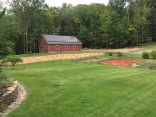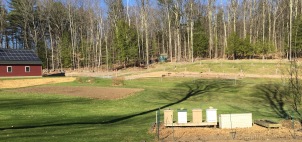Our website, MorningDewApiary.com, mentions a goal of our apiary is to improve the genetics of the bees in our care. During the past 3 seasons I have tried to be selective in the queens we bring into our hives. This experimentation has been relatively successful with a couple notable mistakes–the latest was bringing in a BeeWeaver queen from Texas last fall. Though she overwintered well and is a fantastic layer (I counted 12 frames of brood in the hive today) the bees are simply nasty–quickly becoming aggressive when I’m working the hive and often harassing us as we work in other areas of the yard. This queen must go and I believe the best way for us to replace her is with the genetics from an overwintered, northern raised queen.
If you have been following this blog for any length of time you are aware that I am a fan of Mike Palmer. Mike is a very well respected commercial beekeeper in St Albans, VT. His apiaries produce thousands of pounds of honey and he overwinters over 700 hives each year in Vermont! In addition, he has a very successful queen breeding business and also overwinters hundreds of nucs each year created from his own breeding stock. Much of what I have learned as a beekeeper comes from Mike and my apiary has benefited greatly by using his queens. Mike follows much of the same philosophy as Brother Adam from Buckfast Abbey and is referenced in numerous beekeeping books and journals. I could think of no better way for our club, the Monadnock Beekeepers Association, to learn how to raise our own queens than by having Mike visit us and share his techniques.
Gayla and I hosted the class last Sunday with 12 members in attendance. Mike took us through his method of queen rearing and did the actual grafting. Here is the procedure I followed to get the hives ready for the class and what the rest of the day entailed.
Prepping the Starter Hive
Ten days prior to grafting select the hive that will provide the nurse bees for the cell builder hive. I chose Hive 4, the BeeWeaver hive, as it was very active, had both capped and uncapped brood and I knew I wanted to requeen it soon. As mentioned, this is the hive that will provide only the nurse bees. One of the hives with a Palmer queen will provide the larvae for the grafts so I am not raising daughters with the nasty genes!
I took the hive apart, found the queen and placed her in the bottom super. I then completed a thorough hive inspection, making sure there was not a surprise 2nd queen hanging out. I pulled 6 frames of uncapped brood and placed them in the center of another super. After placing 2 frames of honey in the outside spaces and then 2 frames of pollen in the 2 and 9 positions I set this super aside. I replaced the rest of the supers above the queen and postioned a queen excluder on top. The super with the uncapped brood was then stacked above the excluder. This gave me a hive with 4 supers below the excluder–where the queen and the capped brood resided–and a super with uncapped brood above the excluder. The purpose for this is to make the top super what Mike calls “hopelessly queenless”. With the queen laying below the excluder, the hive remains queen-right. The super above the excluder will continue to raise the uncapped brood as normal.
Nine days later, dancing between raindrops, I inspected the entire hive making sure there were no queen cells being formed above or below the excluder. The hive was now ready for the class.
The Cell Builder or Finishing Hive
The May monsoons let up long enough for us to actually have Mike visit and give the class. After discussions about overwintering nucs, we discussed the plan for raising queens. Mike introduced us to the Chinese grafting tools he would use and discussed several different ways to raise queens. So not to make this post into a book, I suggest any time you have the opportunity to visit with or take a class with Mike, do it! Mike should have been a teacher. His approach to beekeeping is pragmatic, thoughtful and is readily shared by Mike– regardless if it means he may sell less queens or nucs to the club next year (but I doubt it!). He simply wants to help you and your bees succeed. Ask a question, get an answer, no BS…
Out to the hives we went. We removed the “hopelessly queenless” super and set it aside. We then slid the rest of the hive back and rotated it so it was facing the opposite direction. Putting a new screened bottom board where the original hive was, we then placed a new super on the SBB and filled it with 10 frames of honey to serve as food for the bees to raise the soon to be grafted cells. The queenless super was now placed above the honey super and, using a shaker box to make sure we did not accidentally dump in the queen, we shook 4 frames of nurse bees from the original hive onto the frames and closed up both hives. Now we had the original queen-right hive sitting behind the new hive that will serve as the cell builder hive. This hive is “hopelessly queenless” as it has only capped brood and there is no possible way for them to raise a queen of their own as there are no eggs in the hive. We left the hives in this configuration for the next 2 hours as we went and ate a pot luck lunch (thanks for the great food everyone!) and continued the bee stories.
Cell Bars and Grafting
The 2 hours flew by and it was time for the main event! The queenless bees in the new cell builder hive were angry and were definitely letting us know it. Bees were flying everywhere!
We went into one of the Palmer queen hives and found several frames that contained larvae that were approximately 12 hours old sitting in royal jelly.
Using the Chinese grafting tool and a magnifying visor, Mike slipped the grafting tool into a cell and ever so gently slid the tip of the tool under the jelly and larvae and remove them from the cell. He then placed them in one of the plastic JZsBZs cups we had attached to the medium cell bar frame I made. As my hives are all mediums, I had to make a medium cell bar frame to hold the cups for the grafted larvae. If you have deeps you can buy the frames, cups, etc from Brushy Mountain or Dadant.
Once Mike had transferred 20 larvae, we removed a frame from the queenless super and placed the cell bar into the spot, right next to a full frame of pollen and nectar. The response of the hive was almost immediate! As Mike said, it’s like the bees just gave out a contented sigh. Within 5 minutes all of the bees were in the hive, the hum was back to normal and the nurse bees were undoubtedly carrying out their tasks of raising 20 queens.
Reassembling the Hive
Yesterday was day 6. The queen cells are capped by day 5 so I was now able to reassemble the original hive and get a peek at how well we did. I moved the cell builder hive to the side, reversed the direction of the queen-right hive and placed it back in its original position. Taking a look in the hive showed me the queen was fine as she was laying across 3 supers. I’m going to hate pinching that girl (sounds sexist but it’s a euphemism for killing the old queen) but she sure is raising some mean bees!
I placed the super of honey from the cell builder hive on top of the other supers and carefully placed a queen excluder over it. After all this work, the last thing we need is for the queen to make her way up into the super with the cell builder and have her kill the queen cells! I then placed the cell builder super onto p of the excluder and pulled out the frame to have a look. Seventeen of the 20 cells are viable and look great! I gently replaced the frame, added the inner cover with shims for a top entrance and placed on the telescoping cover. Normally, we’d let the queens incubate until day 10 and then pull the cells and place them in nucs, queenless hives etc. As I have a shoot in Toronto on Wednesday, several members of the club will come Tuesday afternoon (day 9) and we’ll distribute the cells across 7 different apiaries. If all goes well, we’ll have New Hampshire raised queens to brag about soon!
Note:
To keep this as short as possible, I have left out the reasoning behind some of the steps. That is what books are for. Here are 2 very good books on raising queens that I can recommend. Either can be purchased online or from the publisher. The first is by Brother Adam and is titled Breeding the Honeybee. The 2nd is by Dr. Larry Connor and is Queen Rearing Essentials from Wicwas Press.
My thanks go out to the Monadnock Beekeepers Association for allowing me to host this wonderful class, to my wife and best friend, Gayla, for doing all of the prepping and cooking so I could pay attention (and not accidentally poison anyone with my culinary ineptness) and to my friend Mike Palmer for his time and willingness to make us all the best beekeepers we can be.
































































really great post! do you plan on offering Queens at some point in the future? it would be wonderful if New Englanders could rear Queens appropriate to our challenging environment.
Thanks, Luddite. I want to test several batches to make sure we’re raising queens worth having, as in gentle producers who overwinter well. If the nucs were making now and the hives we are requeening survive the winter, we’ll probably start selling local queens next June. I believe local queens and nucs are critical to successful beekeeping in New England. I cannot tell you how many people I know who end up buying packages every year because the bees simply do not survive or end up swarming. Now, all bees swarm but surviving the season and into the next is what we should expect and not be surprised when it happens.